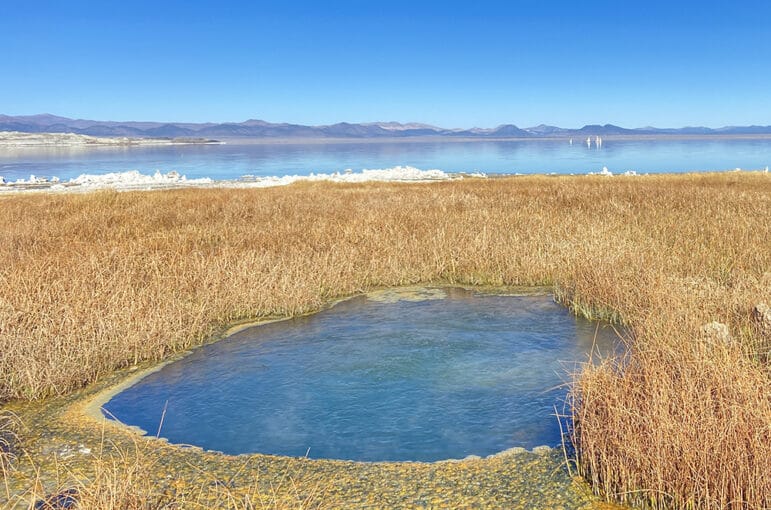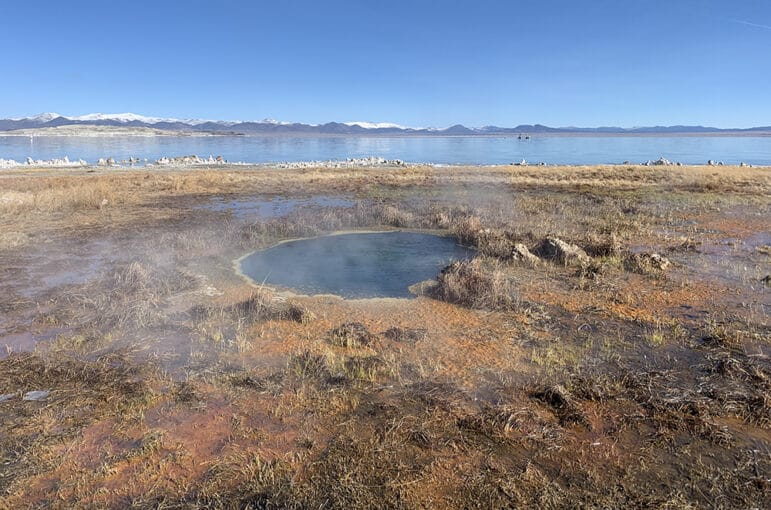
Wild horses, previously seen rarely and only in remote parts of the Mono Basin, have experienced rapid population growth in the past five years—so much that they have expanded far beyond their home territory near the Nevada state line and now routinely reach South Tufa and the shoreline springs and wetlands at Mono Lake where they congregate to drink brackish water and graze on vegetation.
Horses are magnificent animals and inspire people across the West, but they have expanded out of their historical territory due to the growth of the herd. Their large numbers are proving to cause significant damage to sensitive protected habitat.
Increased impacts on places, habitats, and wildlife that people have been working for decades to protect and restore at Mono Lake have put a spotlight on the horse herd growth and range expansion into the Mono Basin.
Safety along roads in the area—for people and horses alike—is also a significant and increasing concern, as is the safety of visitors who encounter horses and approach them.
Increased horse population
According to the Bureau of Land Management (BLM), the horses in the Mono Basin belong in the Montgomery Pass Herd Management Area—a home range of 50,000 acres of mixed public lands located north of Montgomery Pass off Highway 6, primarily in Nevada, about 30 miles east of Mono Lake.
The BLM lists the sustainable size for the Montgomery Pass herd as 138–230 horses, though that figure is from 1988. Last November the Inyo National Forest conducted a single-day aerial survey and counted 642 horses in the herd, 498 of which were found outside of the herd’s regular territory, and approximately 200 of which were in the Mono Lake area. On-the-ground observations have recorded well over 300 horses along Mono Lake’s shore.
Management action needed
With the herd population increase and range expansion, the severity of the habitat damage, and the possibility of movement of horses in the direction of Highway 395, management agencies are working to protect both the resources at Mono Lake and the health and safety of horses and people.
The Inyo National Forest is the lead agency for horse management on National Forest System lands in the Mono Basin and is monitoring the situation with urgency due to the rapid migration of the herd westward and the resulting impacts to natural resources and risks to the horses. Essential to any next management steps is for the agencies to get accurate numbers on the herd size and distribution.
Mono Lake Tufa State Natural Reserve staff have been documenting impacts to the springs, wetlands, and tufa for several years and is working to protect the sensitive habitat and resources in their charge. Because of the extensive wetland habitat degradation, State Reserve biologists are researching and planning a pilot program to test an exclosure fence that would protect some critical spring and wetland habitat while leaving other areas unfenced. The State Reserve is also concerned about the destruction of unique tufa resources which, unlike trampled and overgrazed vegetation, cannot be restored.
Many visitors know of the warm spring between South Tufa and Navy Beach on the south shore of Mono Lake. Over the winter, State Reserve staff documented severe encroachment by 200–400 horses, leading to damage to the bubbling spring, tufa, and surrounding wetland.
In light of the wildlife habitat, freshwater springs, and tufa damage, the Mono Lake Committee has been monitoring the issue since 2015 and supports quick and careful agency action. Additionally, visitors should be aware that these are wild, not tame, animals, and people should never approach or attempt to pet or feed these horses.
More to the story
If you see wild horses at Mono Lake, it is important to know that they bring with them a complicated story. Horses are protected by federal law and their numbers are dramatically increasing across the West. Regionally, the multiplying horse population has pushed these iconic creatures out of their regular range, putting them into direct competition with the diverse bird life at Mono Lake such as wetland dwelling shorebirds, ducks, and songbirds, as well as causing inadvertent but significant impacts to rare alkali meadows, wetland habitat, and world-renowned tufa towers.
The Mono Lake Committee supports the Inyo’s and State Parks’ urgent investigation of this issue, as well as projects to protect the tufa, springs, wetlands, and wildlife on the shores of Mono Lake.
This post was also published as an article in the Summer 2021 Mono Lake Newsletter. Top photo courtesy of Jack & Petra Clayton.


